Hello students! Are you looking for clear, well-written answers to guide you through your studies? You’re in the right place! We’ve provided easy-to-understand, grammatically correct answers for this unit that will help you grasp the material confidently. Take your time to go through them carefully—our aim is to clear up any confusion and make sure you understand the lesson.
Our team of English experts, educated both in India and abroad, has thoughtfully answered all the questions, discussions, and activities in the lesson. This will help you study stress-free and excel in your exams!
Stay focused, stay motivated, and remember: the effort you put in today will pay off tomorrow. Good luck—your success is just ahead!
Find Solutions to NCERT Class 6 English Poorvi Unit 3 Nurturing Nature Chapter 9 ‘Spices That Heal Us,’ here.
Let us do these activities before we read. (Page 93)
1. A spice is any seed, fruit, root, bark, leaf or any other part of a plant used to give taste and colour to our food. Try to recall the names of three spices that are used for cooking in your home. Write them below and share your answers with your teacher.
(a) _______________ (b) _______________ (c) _______________
Answer:
Three spices used for cooking at home are:
(a) Ginger
(b) Turmeric
(c) Cumin seeds
2. Given below are pictures of some spices. Work in pairs and write what you call them in your language. Their names in English are given in the last column. Share your answers with your teacher.
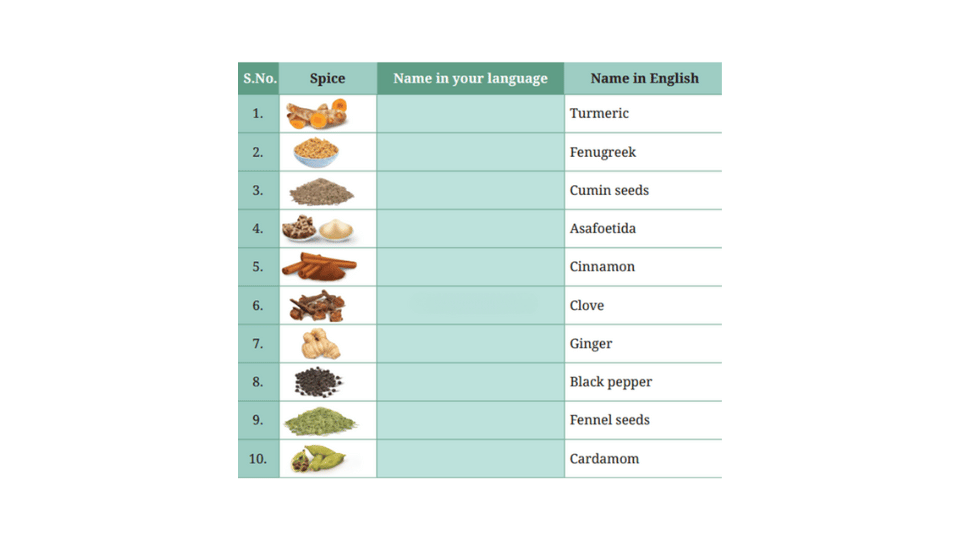
Names of the spices in Hindi (my language) are:
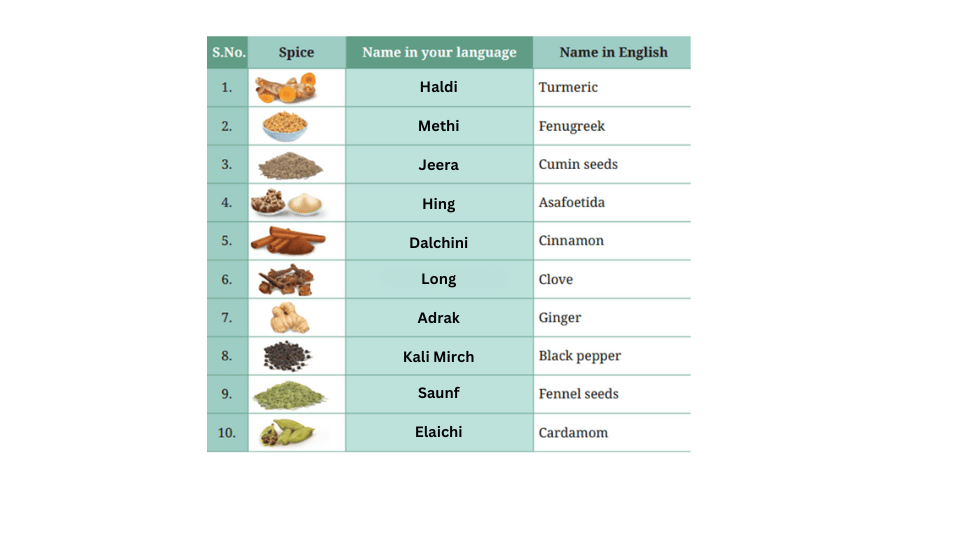
Let us think and reflect (Page 95)
1. Read the given lines and answer the following questions.
‘When I was a child, I learnt them from my grandmother. She used to find cures for most of the weather-related common illnesses in the kitchen.’
(a) Where exactly in the kitchen did her grandmother find the cures?
Answer:
Daadi found the cures in the kitchen, specifically using various spices stored in the spice cabinet.
(b) Give one example of weather-related common illnesses.
Answer:
One example of a weather-related common illness is the common cold and cough.
(c) What kind of relationship did the speaker have with her grandmother?
Answer:
The speaker shared a warm and affectionate relationship with her grandmother who teaches her about natural remedies.
2. Fill in the blanks to complete the sentence.
Daadi soaked methi seeds overnight and drank the water in the morning to manage _____________ and ______________.
Answer:
Daadi soaked methi seeds overnight and drank the water in the morning to manage sugar levels and body weight.
3. Circle the spice that is not useful for body pain according to Daadi’s letter:
(a) Turmeric
(b) Ginger
(c) Fennel seeds
(d) Black pepper
Answer:
The spice that is not useful for body pain according to Daadi’s letter is:
(c) Fennel seeds
4. Why did Daadi ask Vikram and Vaibhavi to share the natural cures with their friends?
Answer:
Daadi asked Vikram and Vaibhavi to share the natural cures with their friends to spread knowledge about traditional remedies that can help others as well.
5. What was Daadi’s final advice to Vikram and Vaibhavi?
Answer:
Daadi advised Vikram and Vaibhavi to remember these natural cures and consult an elder before using any of the spices for healing.
6. How do we know that natural cures are passed from one generation to another?
Answer:
The letter shows that Daadi learned these remedies from her grandmother, indicating that knowledge of natural cures had been passed down from previous generations. In turn, Daadi imparted knowledge about natural cures to her grandchildren demonstrating how she also passed the knowledge to the next generation..
7. Why do you think we should know about the healing properties of spices?
Answer:
Knowing about the healing properties of spices can help us use natural remedies to treat minor health issues, making us more self-reliant and connected to traditional practices.
Let us learn (Page 96)
1. You have read the uses of spices in the letter. Complete the following table with the help of your teacher. You may use the words from the box given below.
| Part of the plant: root/bark/leaves/flower buds/fruit/seeds |
| Texture: rough/soft/silky |
| Taste: bitter/sweet/sour/salty/spicy |
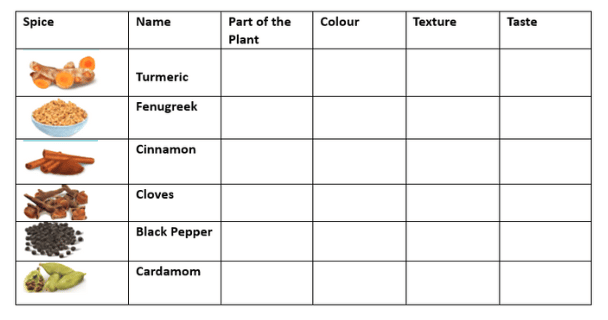
Answer:
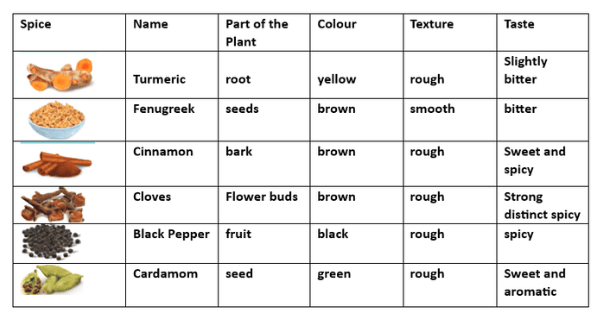
2. Read the sentences given below.
• You may share them with your friends.
• You should try to remember these cures.
• It can help to control cough and cold.
• You must consult an elder before you use them.
• I need to soak the methi seeds overnight.
• I used to put heeng water on your tummy.
The helping verbs in Column A are called modal verbs or modals. Match the modal verbs in Column A with their functions in Column B
| Column A | Column B |
| 1. may | a. past habit |
| 2. should | b. suggestion |
| 3. can | c. compulsion |
| 4. must | d. advice |
| 5. need to | e. ability |
| 6. used to | f. necessity |
The helping verbs in Column A are called modal verbs or modals. Each modal verb has a different function
Answer:
| Column A | Column B |
| 1. may | a. suggestion |
| 2. should | b. advice |
| 3. can | c. ability |
| 4. must | d. compulsion |
| 5. need to | e. necessity |
| 6. used to | f. past habit |
(b) Complete the following dialogues with any four modals from the table given above.
(Use a modal only once.)
Ajay : Anand had fever last week. He (i) _____________ take good rest.
Suman : Yes, he (ii) _____________ or he will fall ill again.
Ajay : He (iii) _____________ take grandmother’s natural cures.
Suman : Yes, we (iv) _____________ remember how effective they are.
Answer:
Ajay: Anand had fever last week. He (i) should take good rest.
Suman: Yes, he (ii) must or he will fall ill again.
Ajay: He (iii) can take grandmother’s natural cures.
Suman: Yes, we (iv) need to remember how effective they are.
Let us listen (Page no 98)
You will listen to the benefits of Tulsi (Holy Basil), a common herb. As you listen, complete the factsheet given below. (refer to page 102 for transcript)
| The Wonder Herb | ||
| Name | Tulsi | Family: (i) _____________ |
| First found in | (ii) ____________ | |
| Now found | everywhere in India | |
| Known as | The (iii)_____________ of herbs | |
| Can decrease levels of | (iv)_____________ and cholesterol | |
| Used to treat disorders of | breathing and (v) _____________ | |
| Is used to make | mouth wash and (vi) _____________ | |
| We can have Tulsi leaves by | eating them (vii) _____________ or adding them while making (viii) _____________ | |
Answer:
| The Wonder Herb | ||
| Name | Tulsi | Family: (i) Basil |
| First found in | (ii) North central India | |
| Now found | everywhere in India | |
| Known as | The (iii) Queenof herbs | |
| Can decrease levels of | (iv) glucose and cholesterol | |
| Used to treat disorders of | breathing and (v) digestive disorders | |
| Is used to make | mouth wash and (vi) toothpaste | |
| We can have Tulsi leaves by | eating them (vii) raw or adding them while making (viii) tea | |
Let us speak (Page 98)
1. Daadi told Vikram and Vaibhavi about many spices. Choose one spice and introduce yourself as that spice to the class.
2. Before you speak, make a spicy headband for the spice you chose. Follow the steps given below.
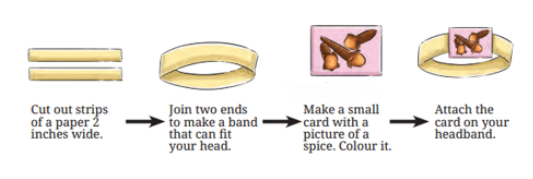
Cut out strips of a paper 2 inches wide. Join two ends to make a band that can fit your head. Make a small card with a picture of a spice. Colour it. Attach the card on your headband. Use the headband while introducing yourself as the spice.
3. Mention the following while speaking.
• your name • part of the plant
• colour • texture
• taste • benefits
Answer:
First make a headband following the steps provided below:
Cut paper strips: Start with a sheet of paper and cut it into strips that are 2 inches wide. Make sure the strip is long enough to wrap around your head comfortably.
Form the headband: Take the two ends of the strip and bring them together to form a circular band that fits around your head. Use staples to hold the ends securely in place.
Draw a turmeric card: Make a small card with a drawing or picture of turmeric on it.
Affix the card to your headband: Place the turmeric card at the front of your headband and secure it with glue, tape, or staples to keep it in place.

Now that your headband is ready, put it, face the class with a smile and introduce yourself.
Speech by Turmeric
“Hello, friends! I am Turmeric, one of the most popular spices in the Indian kitchen! Here are a few facts about me:
My name: Turmeric and scientists call me ‘curcuma longa.’
Part of the plant: I’m the root, which grows underground.
Color: I’m a bright yellow-orange on the inside, but my skin looks a bit brown.
Texture: When I’m fresh, I’m firm and a little bumpy. Once I’m dried and ground, I become a smooth, soft powder which you see in your kitchen.
Taste: I have a warm, earthy taste with a touch of bitterness. I’m also slightly peppery.
Benefits: People love me for more than just my taste! I’m good for health too. I can help reduce swelling, fight off sickness, and improve digestion. I’m also used to relieve pain and keep skin healthy and glowing. And that is not all, I can also boost up your energy, so try me when you feel run down.
Thanks for listening! I’m always happy to add a bit of golden colour and goodness to your food and health!”
Let us write (Page 99)
1. Vikram’s grandmother shared two natural cures to cure his cough in her earlier letter. It was kept outside and a few drops of rain fell on it. Some of the words got washed away by the rain. Help Vikram complete the natural cures. Use the phrases given in the box below. There are two phrases that you do not need.
| some leaves of basil | for cough | amount of honey |
| the mixture | for high fever | a piece of fresh ginger |
| you can have it | grind to get | home remedy |
Natural Cures for Cough
(a) To prepare this home remedy, you just need ginger and honey. First, take a __________, grate it and take the juice from it. Take about two teaspoons of this juice and add about two and half teaspoons of honey to it. Mix it properly. Warm ____________________ slightly on very low heat for a minute. Then ____________________ about three to four times a day to get relief from cough. Have patience to see the effect as natural cures ____________________ with ginger and honey might take some time to show results.
(b) To prepare the second ____________________ for cough, take about 10 grams of each long pepper, dried ginger and basil leaves. Add four to six small cardamoms and ____________________ a fine powder. If you take this powder with an equal ____________________, it will give you relief from cough
Answer:
(a) To prepare this home remedy, you just need ginger and honey. First, take, a piece of fresh ginger grate it and take the juice from it. Take about two teaspoons of this juice and add about two and half teaspoons of honey to it. Mix it properly. Warm the mixture slightly on very low heat for a minute. Then you can have it about three to four times a day to get relief from cough. Have patience to see the effect as natural cures for cough with ginger and honey might take some time to show results.
(b) To prepare the second home remedy for cough, take about 10 grams of each long pepper, dried ginger and basil leaves. Add four to six small cardamoms and grind to get a fine powder. If you take this powder with an equal amount of honey, it will give you relief from cough.
2. Now, write a short paragraph on Tulsi based on the completed factsheet in ‘Let us listen’. (page 100)
Answer:
Tulsi: The Queen of Herbs
Tulsi, an exceptional shrub from the basil family, is known as the “Queen of Herbs” due to its extensive medicinal benefits. From north-central India where tulsi originated, it has now spread to many parts of the country. This herb is highly sought for its ability to lower blood glucose and cholesterol levels, as well as improve blood pressure, making it beneficial for overall health. Tulsi is often used to treat breathing and digestive problems. It is a popular ingredient in herbal hand sanitizers, mouthwash, and toothpaste on account of its anti-bacterial properties. These products ward off bad breath, gum disease, and mouth ulcers. Tulsi leaves can be eaten raw after washing or added to tea for a calming effect as it helps reduce stress. Moreover, Tulsi protects us from various pollutants, acting as a natural shield against harmful environmental elements.
Let us explore (Page 100)
1. Now that you have read about many spices, can you guess the spices based on the riddles given below?
(a) When your tummy felt funny
I was used by your granny
I made you fit and fine
And brought back your smile.
Who am I?
________________________
Answer:
Asafoetida (heeng)
(b) I come from under the ground
Thousands of years, I’ve been
around.
For cooking you use me daily
From cold I can cure you surely.
Who am I?
________________________
Answer:
Ginger (adrak)
2. Fill in the blanks to complete the riddle below.
(a) Brownish- _________ in colour,
and _________ to taste,
I help everyone,
to _________ their weight.
Who am I?
Answer:
(a) Brownish- yellow in colour,
and bitter to taste,
I help everyone,
to lose their weight.
Who am I?
Answer: Fenugreek (methi)
(b) Write another riddle of your own and ask your family members to guess the spice.
Small and slender, I’m brown in hue,
I add flavour to dishes, that’s true.
With a warm, earthy taste, I’m a must,
To aid digestion, in me you can trust.
Who am I?
Answer: cumin (jeera)
3. Close your eyes and learn about spices by smelling and feeling them.
Answer:
Steps for the Spice Sensory Exercise:
Prepare the Spices with the help of your teacher:
Collect a variety of spices such as cumin, cinnamon, cardamom, turmeric, cloves, pepper etc.
Place each spice in separate bowls to ensure they’re not mixed.
Set the Atmosphere:
Ask the students to sit comfortably at their desks or in a circle.
Ensure the room is quiet and free of distractions.
Instruct the students to close their eyes to engage their other senses, especially smell and touch.
Encourage them to take a few deep breaths to calm and focus their attention on the task.
Introduce the Spices One by One:
Begin by giving each student a spice one at a time. Ensure they do not know which spice it is at first.
Ask them to smell the spice deeply and try to identify any distinct scents.
Encourage them to feel the texture of the spice (whether it’s rough, smooth, soft, or hard) using their fingers or palms.
After each spice, ask the students:
“What does it smell like?”
“Can you describe its texture?”
“Does it remind you of anything, like food or a place?”
Write or Share Observations:
Once they’ve had time to smell and feel each spice, ask students to either write down or share their thoughts about the spice they just explored and also guess the name of the spice based on the clues gathered.
After the students have shared their guesses, reveal the correct spice and discuss its uses and benefits.
This exercise helps students engage their senses and learn about spices in a fun, hands-on way!
Frequently Asked Questions (FAQs) on NCERT Class 6 English Poorvi Unit 3 Nurturing Nature Chapter 9 ‘Spices that Heal Us”
We have seasoned English experts on staff who have taken care to explain the lesson to you in a lucid and easy-to understand manner. Solutions to all end text questions and in-text activities have been provided which cover the lesson in detail and help you focus on the important aspects.
You can also download the free PDFs of the solutions anytime you please! We will keep providing you with plenty of top-quality study material and resources to help you prepare. So, make sure you keep visiting our website and join our email list to take advantage of them! (insert hyperlink)
Yes indeed! You can download the free PDF versions of these excellent solutions anytime (please look towards the top of the page)!.
Our experienced English faculty have crafted these solutions which guide you to notice every detail of the lesson. We advise you to go through the text at first and look up the meanings of words that you might not know. This step must not be skipped as it will not only help you to understand the lesson better, but also enrich your vocabulary to a great extent. Learn the name of the spices in your own language as well as the English names. You may ask your mother to help you with this part.
Then you need to go through all the answers we have thoughtfully provided – both to the questions at the back of the lesson as well as the in-text questions and activities in order to grasp the essence of the lesson. Pay close attention to details. Do not memorise because understanding the text is the key to learning.
Subsequently, you need to practise writing down the answers within a specific time frame. You can then ace your exams! There is no short cut to success! Systematic study will help you achieve what you want.
Feeling lost or anxious about your studies and future? We understand how overwhelming it can be to face these challenges alone. But don’t worry, you’re not alone—we’re here to help.
At educationroundtheworld.com, we connect you with dedicated teacher-mentors who are passionate about guiding students like you toward success by offering the support you need to achieve your goals.
Book your first session with us to begin the process of creating a customized study plan that suits your unique needs and aspirations. Together, we’ll focus on building your confidence and skills so you can move forward with a clear, actionable plan for success.
Say goodbye to the stress and uncertainty—let’s work together to pave the way for your bright future, starting today!
Take the first step now—reach out to us and unlock your full potential!


